Khao Yai National Park
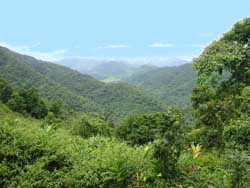
Khao Yai National Park is one of the finest natural attractions in Thailand. It became Thailand's first national park in 1962. It covers 2,166 square kilometers of the Dong Phaya Yen Mountain Range, which makes it the second largest national park in the country. 'Khao' is Thai for hill and 'yai' means big. Therefore, Khao Yai means big hills.
In 1988 Khao Yai National Park was recognised as an Asean Heritage Park. In 2005 the park was declared a Natural Heritage by Unesco.
The park area is spread across four provinces, Nakon Nayok, Prachinburi, Saraburi and Nakon Ratchasima (Korat). It contains a wide range of plant and animal life including elephants, bears, gibbons, deer, gaur, wild pigs, porcupines, civet cats and even a handful of tigers.
A road runs through the park and the central area has tourist facilities such as a museum, accommodation and food. The majority of the rest of the park is jungle and grassland.
Climate
 The park's altitude ranges from 350m to 1350m at the highest point at Khao Rom. This
means that the temperature is generally a little lower than in the plains. In fact, it can
be distinctly chilly at night.
The park's altitude ranges from 350m to 1350m at the highest point at Khao Rom. This
means that the temperature is generally a little lower than in the plains. In fact, it can
be distinctly chilly at night.
Rainy Season: May-October. It does rain most days but there are also long dry spells. This is the best time of year to see the waterfalls.
Cold season: November- February. The weather is sunny and cool. It is the ideal time for hiking.
Hot Season: March-April. The maximum temperature does reach 30°C but the temperature is still comfortably cooler than in the plains. The waterfalls are at their least spectacular.
Habitats
Forest: The jungle of Khao Yai National Park consists of various types of forest.
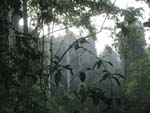 The high humidity areas are tropical rain forest and hilly evergreen forest (mostly above 1,000 meters). This high density jungle covers more than 70% of the park.
The high humidity areas are tropical rain forest and hilly evergreen forest (mostly above 1,000 meters). This high density jungle covers more than 70% of the park.
The lower humidity areas are dry evergreen forest and dry deciduous forest. They are mostly on the lower slopes of Khao Yai. There is also thinner savannah forest around the grassland areas.
This wide variety of forest creates an incredible diversity of plants (more than 2000 recognised species) within the park. There are soaring trees swathed in moss and climbers. There are creepers, jungle flowers, bamboos, ferns, rattan palms, multicoloured lichens and an array of fungiis.
The high humidity levels of an evergreen forest stimulate a high density and diversity of plants and trees. Pristine forest areas have a clearly defined layering of vegetation that accommodates many different types of plants. Available space is shared by various plant and tree types, each having adapted to survive in its own portion of sunlight.
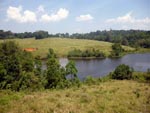 Grassland: The grassland provides an important grazing habitat for herbivores like deer and gaur. The park rangers have done an annual burn every summer for more than 50 years to prevent the jungle from reclaiming the grassland and to promote re-growth of the grass. These are the easiest areas to view wildlife.
Grassland: The grassland provides an important grazing habitat for herbivores like deer and gaur. The park rangers have done an annual burn every summer for more than 50 years to prevent the jungle from reclaiming the grassland and to promote re-growth of the grass. These are the easiest areas to view wildlife.
Salt Licks: The salt licks are scoured areas of earth containing high salt levels that the herbivores like to lick. Some of these are naturally occurring and were dug out by the elephants. Others were created by the park rangers who replenish the salt levels every year. They attract the herbivores and may also occasionally attract the carnivores that hunt them.
Wildlife
Mammals: More than 70 mammal species have been recorded in Khao Yai. These include larger species like elephants, sambar deer, barking deer, gaur, civets, porcupines, wild boars, gibbons, macaques, wild dogs and tigers.
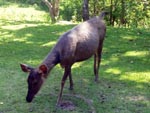 The easiest animals to spot are the deer grazing on the grasslands. The sambar deer are the larger variety that often graze in groups. They are generally not concerned by the presence of humans and in fact some of them are very bold and will approach people for food. You should not feed the animals. The barking deer are smaller and are usually alone or in pairs. They are more skittish than the sambar deer and will flee if approached.
The easiest animals to spot are the deer grazing on the grasslands. The sambar deer are the larger variety that often graze in groups. They are generally not concerned by the presence of humans and in fact some of them are very bold and will approach people for food. You should not feed the animals. The barking deer are smaller and are usually alone or in pairs. They are more skittish than the sambar deer and will flee if approached.
Khao Yai has the largest population of wild elephants in all of Thailand but they are not always easy to find. You may see them in the evening at the salt-licks and sometimes you will see them on the roads as you drive in or out.
The Gaur are large curved horned herbivores that look a little like wildebeest. They are nocturnal animals but are occasionally seen in the grasslands during the day.
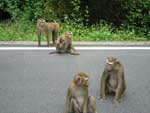 You can often here the strange calls of the gibbons in the forest but they are not always easy to see. If you are a quiet walker you can spot these apes swinging in the trees. The more common macaque monkeys are much easier to spot and will boldly approach people for food. They often reside around the places people gather such as campsites and waterfalls.
You can often here the strange calls of the gibbons in the forest but they are not always easy to see. If you are a quiet walker you can spot these apes swinging in the trees. The more common macaque monkeys are much easier to spot and will boldly approach people for food. They often reside around the places people gather such as campsites and waterfalls.
There is a cave that has over 1 million bats. It is just outside the park, 3km north of the Pak Chong entrance.
You will be very fortunate to see a tiger. Even many of the park rangers have never seen one of these reclusive creatures. The occasional find of tiger droppings is the main evidence that a few tigers do still haunt this area. However a few patient visitors do get fleeting glimpses of these magnificent creatures from the watchtowers as they prowl through the grasslands.
Birds: The park has more than 300 species of birds. Some of them are migratory and others resident all year round. The park has four species of endangered hornbills. Other rare species include the Red-headed Trogon, Golden-fronted Leafbird, Large Cuckooshrike, Verditer Flycatcher and Minivet.
There are also Hill and Common Myna birds that can mimic human voices. There are colourful Little Pippas and Siamese Firebacks. There are also hunting birds such as falcons.
The most popular bird watching sites are in the jungle near the two campsites. Grassland and water fowl can be seen from Nong Pak Chi Watching Tower.
Reptiles: Reptiles are animals that have epidermal scales, breathe with lungs and lay eggs on land. In Khao Yai there are 53 recorded species of reptiles. There are many snakes including reticulated pythons, cobras, cat snakes and bronzebacks. Snakes do not attack people unless they feel threatened but you should be careful when stepping through undergrowth. If you see a snake you should assume it is dangerous unless you know better. There are also monitor lizards, skinks, water-dragons and freshwater crocodiles.
Amphibians: Amphibians are the animals that can live both in water and on land. They have skin, not scales or fur, lay their eggs in water and their babies are born with gills. In Khao Yai there are 18 recorded species of amphibians including tree frogs, paddy frogs, grass frogs and bullfrogs.
Insects: The number of species of insect in Khao Yai is virtually uncountable. There are around 5,000 species of butterfly. The Cicadas rarely stop their incessant background jungle humming.
Waterfalls
There are many waterfalls within the park, some of which can be very spectacular during the rainy season. They certainly should not be compared with the fun-to-play waterfalls of Nakhon Nayok such as Sarika and Nang Rong. The flow is often far too powerful and it would be dangerous to enter the water. There may also be blood sucking leaches in some locations.
Heaw Narok Waterfall
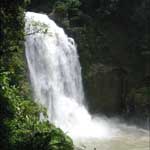 This is the highest waterfall in Khao Yai. It cascades over three levels with
the final level hurtling 80 meters into a deep abyss. At the height of the
rainy season, this waterfall is a truly fearsome sight. In fact, almost
every year at least one elephant loses its life after slipping into the
treacherous water.
This is the highest waterfall in Khao Yai. It cascades over three levels with
the final level hurtling 80 meters into a deep abyss. At the height of the
rainy season, this waterfall is a truly fearsome sight. In fact, almost
every year at least one elephant loses its life after slipping into the
treacherous water.
Heaw Narok (hell abyss) is on the south side of the park (in Nakon Nayok province). There is a 2km hike from the road through the jungle to the falls.
Heaw Suwat Waterfall
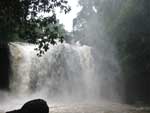
This is the waterfall that Leonardo DiCaprio jumped off in the movie 'The Beach'. Of course, it is nowhere near a beach but such is the magic of Hollywood. It is a wide fall with a 20-meter drop.
You can easily reach this waterfall at the end of Thanarat Road in the center of the park. There is a viewpoint at the top and you can go down to the base of the falls.
Heaw Sai Waterfall
This is an interesting fall. A stream cascades over angled rock and drops 5-meters down a step formation. This fall is an 800-meter walk from Heaw Suwat Waterfall.
Heaw Pratoon Waterfall
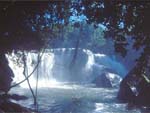
This is a very beautiful fall. It cascades down 30 meters over a wide, jagged cliff. The water then swirls around some huge boulders at the base of the falls.
You can reach this fall with a 2.5km walk along a path from Heaw Suwat Waterfall or an 8km trek from the park headquarters.
Wang Heaw Waterfall
This is a big and spectacular fall. It is 60-meters across with lots of water pouring over the edge. This is a fall for serious trekking enthusiasts. It is a 2-day trek to the east of the park.
Trekking
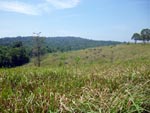
There are plenty of trekking trails around the park. There are many short trails for the casual trekker to enjoy the natural beauty of the park. These range from 1 to 9 kilometers. Several of these start at the park headquarters. There is an 8.5km trek from the park HQ to Heaw Suwat Waterfall that also passes a couple of other falls on the way.
For the serious trekking enthusiast, there are some trails into the depths of Khao Yai that will take 3-4 days to complete. You will be going into the depths of the jungle.
You should always inform park rangers before starting a trek. Guides are available at the park headquarters for a small charge.
Other Activities
Park HQ and Museum
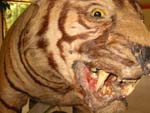
The park headquarters are in the central area of the park. You can get information about the park's attractions and arrange guides, tours or accommodation.
There is also a museum with lots of great stuff about the park. There are photos and models of many of the species in the park and even a stuffed tiger. It was hunted down after it attacked and killed a local villager. Don't worry, such events are very rare.
Night Time Spot Light Tour
You can take a jeep safari spot light tour in the early evenings. These spot light tours start after sunset. They drive around the roads and tracks of the central park area, shining spotlights on the wildlife in the forest and grasslands. You will see lots of deer, which are confidently unconcerned by the spotlights. You may well see porcupines or even rarer animals such as civet cats or wild pigs. If you are lucky, you may see some elephants. These tours can be booked at the visiitor center. They start at 7pm or 8pm and take around 1-hour.
Animal Watching Towers
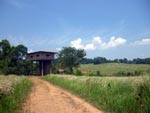 There are two wildlife observation towers in the central area of the park at Nong Pak Chi and Mo Singto They are just short hikes from the main roads. They are located near lakes, grasslands or salt licks that attract wildlife to gather. The better location is Nong Pak Chi Tower. Access to the tower is from the main road just 2km south of the park HQ. It is an easy 900-meter walk from the road to the tower.
There are two wildlife observation towers in the central area of the park at Nong Pak Chi and Mo Singto They are just short hikes from the main roads. They are located near lakes, grasslands or salt licks that attract wildlife to gather. The better location is Nong Pak Chi Tower. Access to the tower is from the main road just 2km south of the park HQ. It is an easy 900-meter walk from the road to the tower.
The Nong Pak Chi grassland has a dry salt lick and a lake so it attracts many animals such as sambar deer, muntjac, elephants and wild boars. The presence of so many herbivores naturally occassionally attracts the attention of predators such as tigers, wild dogs and pythons. You can settle in at one of the windows and just watch the animals in their natural environment. You can take water but no other food or drink. Early mornings and early evenings are the best times to see wildlife.
Bike Rides
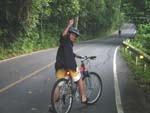
You can rent mountain bikes from the park headquarters or at the campsites. They are a fun way to explore the roads of the central area of the park. However, believe us when we say you have to be fit to cope with the steeper slopes of the park. You should always inform the park rangers if you plan to stray off the main roads.
White Water Rafting
You can arrange white water rafting at the park headquarters. They will take you to the rapids at Kang Hin Perng.
Accommodation
Camping
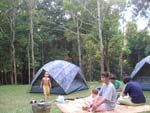
There are two campsites in the central area of the park on the road to HHeaw Suwat Waterfall. You may not camp outside the designated campsites. You can bring your own camping gear or rent at the campsite. They have facilities such as toilets, showers and a small shop. You can light a barbecue but you should not light open fires.
In the evenings, the large sambar deer often walk right into the campsites. They are only grazing for food and do not worry about the campers. If you leave food unattended while you are away from the site, you may well find it is gone when you return. As far as the deer are concerned, unattended food is their food.
Park Bungalows
The park has bungalows for rent and hostels for larger groups. It is basic accommodation but they are all comfortable with bedding, electricity and running water. The bungalow sizes range from 2 people up to 30. You should go to the park headquarters to rent a bungalow but be aware they are often fully booked at weekends. You can book bungalows in advance by telephone +66 (0)2 562 0760. However you will need to send payment in advance by bank transfer to the account details they give you.
Hotels
For something a little more comfortable, there are some nice hotels just ouside the national park.
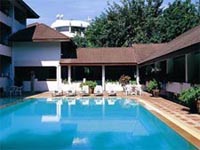 Khao
Yai Grandview Resort (3 star) -- At the Prachinburi side this is a perfect location to base
yourself for a trip to Khao Yai National Park. The resort has amenities
such as TV, fridge, air-con, en-suite bathrooms. It is in a picturesque location on route 3077,
only 150m before the park gates. It has a swimming pool, tennis courts
and mountain bike hire.
Khao
Yai Grandview Resort (3 star) -- At the Prachinburi side this is a perfect location to base
yourself for a trip to Khao Yai National Park. The resort has amenities
such as TV, fridge, air-con, en-suite bathrooms. It is in a picturesque location on route 3077,
only 150m before the park gates. It has a swimming pool, tennis courts
and mountain bike hire.
To get there from Nakhon Nayok -- take route 33 from Nakhon Nayok towards Prachinburi and drive 15km until you reach a traffic circle and turn left on to route 3077 towards Khao Yai National Park.
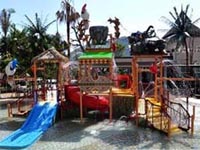 There are quite a few resorts outside the Pak Chong entrance. These are a few examples:
There are quite a few resorts outside the Pak Chong entrance. These are a few examples:
Grrenery Resort - Khao Yai (3.5 star) -- This resort is close to the Pak Chong park entrance. The rooms have TV, fridge, air-con and en-suite bathrooms. The hotel has some nice facilities for children so it is ideal for families. There is a swimming pool, playground, horse riding and ATVs. This resort is located just off route 2090, 2.5km from the Pak Chong park entrance.
To get there from the Nakhon Nayok side you have to drive right through the park and out the other side. Alternatively, come from the Nakhon Ratchisima side and take route 2090 from Pak Chong.
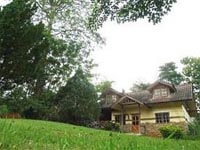 Khao
Yai Cowboy City (3.5 star) -- This resort is close to
the Pak Chong park entrance. It features bungalow accomodation with
fridge, air-con, en-suite bathrooms and wi-fi. It has a nice bar which
has live music in the evenings. The hotel has a swimming pool. This
resort is located just off route 2090 close to the Pak Chong park entrance.
Khao
Yai Cowboy City (3.5 star) -- This resort is close to
the Pak Chong park entrance. It features bungalow accomodation with
fridge, air-con, en-suite bathrooms and wi-fi. It has a nice bar which
has live music in the evenings. The hotel has a swimming pool. This
resort is located just off route 2090 close to the Pak Chong park entrance.
To get there from the Nakhon Nayok side you have to drive right through the park and out the other side. Alternatively, come from the Nakhon Ratchisima side and take route 2090 from Pak Chong.
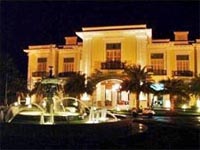 Chateau
de Khaoyai Resort (4 star) -- This is doing Khao Yai in
style. This 4-star hotel is good value for the high standard of accommodation.
The spacious rooms have TV, fridge, air-con and en-suite bathrooms.
The hotel has a swimming pool, tennis courts, gym, sauna, jacuzzi and
golf course. The resort is located just off route 2090 close to the
Pak Chong park entrance.
Chateau
de Khaoyai Resort (4 star) -- This is doing Khao Yai in
style. This 4-star hotel is good value for the high standard of accommodation.
The spacious rooms have TV, fridge, air-con and en-suite bathrooms.
The hotel has a swimming pool, tennis courts, gym, sauna, jacuzzi and
golf course. The resort is located just off route 2090 close to the
Pak Chong park entrance.
To get there from the Nakhon Nayok side you have to drive right through the park and out the other side. Alternatively, come from the Nakhon Ratchisima side and take route 2090 from Pak Chong.
Getting There from Nakhon Nayok
There are two ways to enter Khao Yai Park from Nakon Nayok, the easy way and the hard way.
Driving
The easy way is by road. From Nakhon Nayok town, take route 33 towards Prachinburi and drive 15km until you reach a traffic circle. The left hand turn is route 3077 towards Khao Yai National Park. The park checkpoint is 15km along route 3077 and you will pay your park entrance fee there.
Trekking
The hard way is to trek in through the jungle. It is a demanding 2-day trek into the heart of Khao Yai. These treks started in 1992. They start from the base of Nang Rong waterfall and have become popular with tourists. The trekking season runs from December to June. They suspend the treks over the worst of the rainy season. Note that you need to book these treks in advance with the Tourism Authority of Thailand, Nakhon Nayok Office, tel: 037 312 282 or 037 312 284.
Park entrance is 200 baht for foreigners and 40 baht for Thais.

